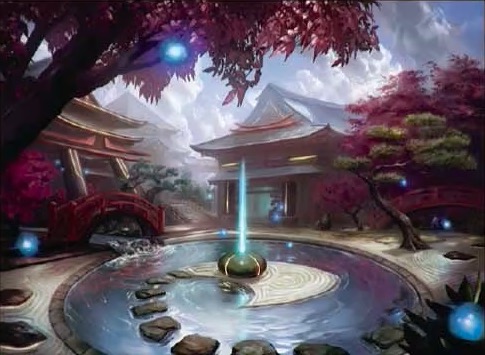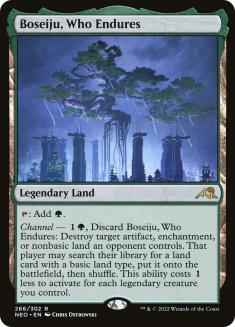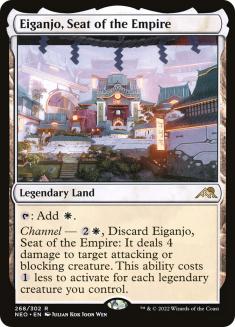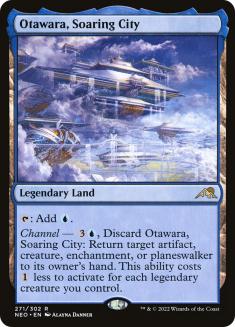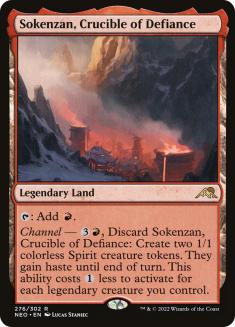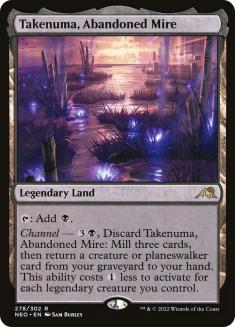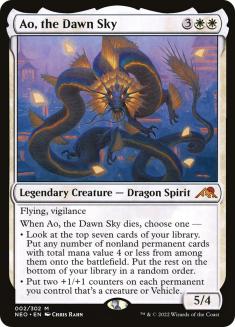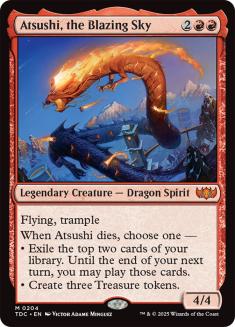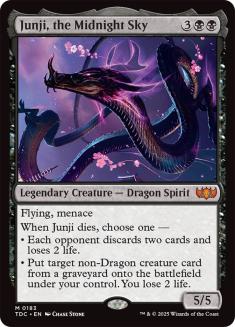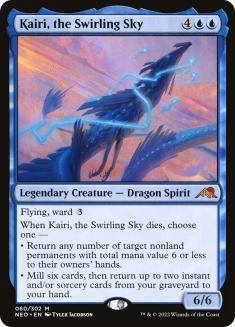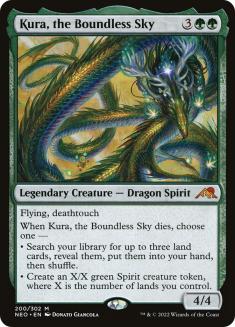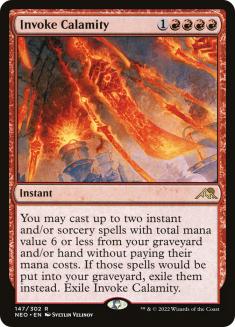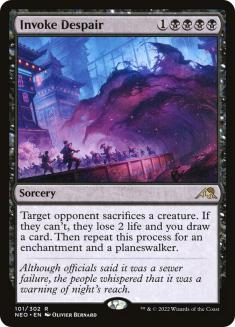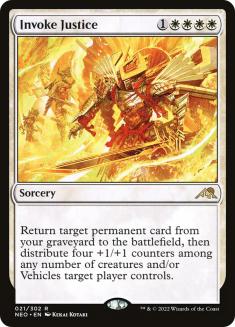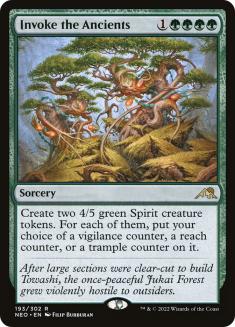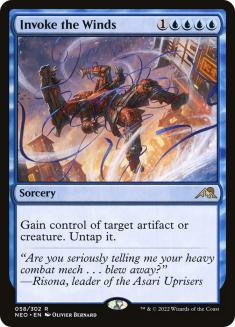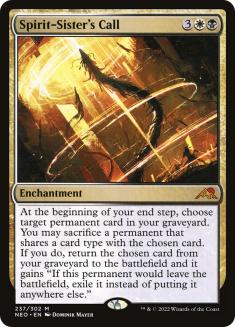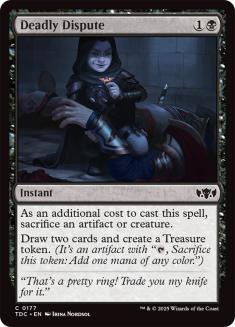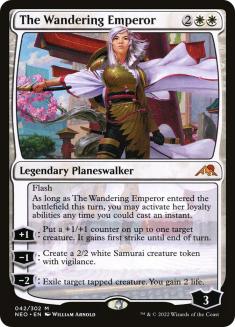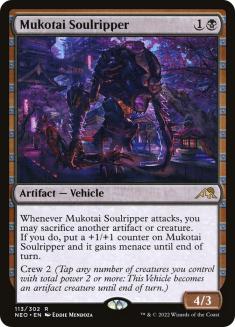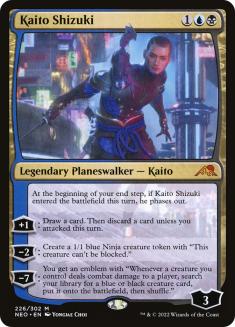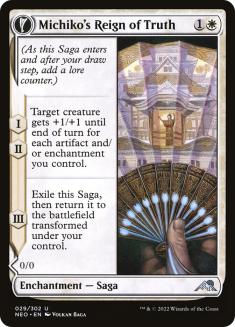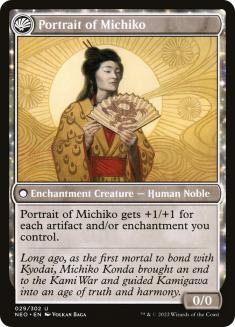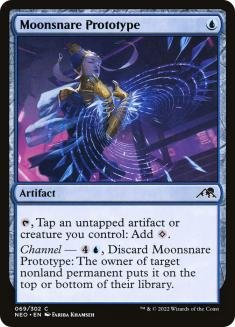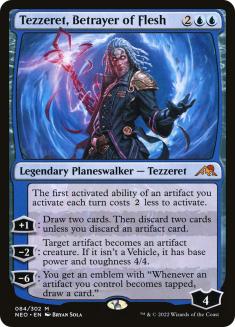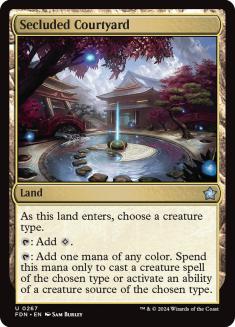I’ve been delving deep into the Pioneer format, and loving every minute of it! Well, maybe not every minute. There are a few minutes here and there when Lotus Field makes me twiddle my thumbs while they do their thing, but most of the minutes are enjoyable!
Pioneer is also one of the formats closer to Standard, and therefore more likely to be impacted by the quarterly set releases. At the moment, Pioneer is in a fun spot. There are a ton of decks to play, and Kamigawa: Neon Dynasty looks like it is going to add even more playable deck and upgrades to the format!
This new adventure in the plane of Kamigawa is packed with flavor, cool new characters, and enough throwback references to make even the most hardened veteran go “ooooh” at least once while watching a set review.
With Kamigawa: Neon Dynasty come three primary cycles of rare cards. One cycle is land-based, one is creature-based, and one is instant/sorcery-based. Today’s article will go over my Top 8 cards for Pioneer from Kamigawa: Neon Dynasty, but I think all three of these cycles will have multiple standouts. We’ll examine them separately from the rest of the eight.
This land cycle is kind of like a “strict upgrade” to any basic land. These will see play in virtually all formats, as there’s virtually no downside to playing one copy and most of the abilities are somewhat decent. I have been comparing them to the Shatterskull Smashing land cycle, in that they’re fine as both a land and a spell, but neither is overly exciting. In Pioneer specifically, I expect most decks to play at least one of these.
Next up, we have the new iterations of the original Dragon Legends.
I wrote my article last week about Junji, the Midnight Sky. I believe it will be an all-star for midrange decks across multiple formats. By contrast, I’m not sold on Kairi, the Swirling Sky, as it seem strange for a creature to have both ward and a “dies” ability. At that point, it basically has hexproof, as it takes too much to interact with it on the battlefield.
Out of all five of these new mythic rares, the only one besides Junji that I love is Atsushi, the Blazing Sky. It being a full mana cheaper than any of the rest means you’re able to play it in a more aggressively slanted deck. Both abilities are excellent when it dies, and the body/cost ratio is clean.
With that said, all of them will likely see play in Standard, but I think Junji and Atsushi are the two most likely to see play in Pioneer, even if they’re battling over those mana slots with some real heaters.
Lastly, we have the Invoke cycle.
Of these five, I think you could argue that all five are powerful enough to see play at some point. The red one, Invoke Calamity, feels like it’s “most likely to be broken” due to two-card combos and maybe playing something from hand that you’re not supposed to play very easily. At five mana, I think these might struggle to find a home in Pioneer, but all of their effects are generically powerful and potentially desirable. For example, Invoke the Ancients creates a ton of pressure with a twist for just five mana, but how good is it compared to Nissa, Who Shakes the World?
With those fifteen pushed cards out of the way, let’s dig deep into the rest of the set to see my Top 8 for Pioneer out of Kamigawa: Neon Dynasty!
8. Spirit-Sister’s Call
I’m a big fan of mopey unbeatable enchantments. I love love love the fact that this card just immediately returns something from the graveyard to the battlefield. It has been giving me real “Recurring Nightmare” vibes, even if you can’t continue to chain off the same card over and over. I also love that this engine doesn’t require a mana investment past the first time.
I don’t actually know where this one will fit in the grand scheme of things, but I have a feeling it will singlehandedly create its own archetype. That’s a hell of a called shot, but cards like this need a lot of dedicated time and effort to get to an optimal build. This is far too complex for me to accomplish on my own, but suffice it to say that there are tons of cards that I wouldn’t mind sacrificing or returning to the battlefield.
Alongside Deadly Dispute, this gives us two potent sacrifice outlets, which means we can easily cast and sacrifice one of those spiffy new legendary Dragons like Junji, the Midnight Sky or Ao, the Dawn Sky.
Please note: the copy has an exile clause that replaces the “dies” ability, so it might not be as sweet as I think.
7. The Wandering Emperor
Control decks have been missing a four-drop planeswalker for a while. I love that The Wandering Emperor can be cast at instant speed, and gives you the option to use a number of powerful, reactive abilities on the turn you cast it. It’s possible I’m misreading just how much this will play in Pioneer, but I think having a flash planeswalker is pretty sick, especially so when it can tag an attacking creature when you first cast it. Sneak attacks are my favorite.
The only downside to The Wandering Emperor is that the play pattern of “kill your creature, create a blocker” puts it at zero loyalty. Maybe that’s balanced, or maybe I’m just looking at it all wrong. Playing The Wandering Emperor in a deck with a few creatures could help protect it, as well as generate a bunch of targets for the plus ability.
In a creature-on-creature matchup, the [+1] ability to add a counter and gain first strike is sick, often allowing you to dominate combat without the threat of counterplay. In addition to that trick, you now have a planeswalker on the battlefield that threatens to remove more creatures or continue to buff your existing creatures.
6. Mukotai Soulripper
When I first saw this card, my jaw dropped. I can’t really explain what it means to have such a large creature in black for just two mana. Vehicles often come with some sort of drawback that balances them out, but even Smuggler’s Copter felt “okay” when we first looked at it. While Mukotai Soulripper won’t be better than Smuggler’s Copter, it could fill the gap that had been previously left behind.
One excellent play pattern of Vehicles is that they allow you to progress your battlefield without making yourself vulnerable to sweepers, sorcery-speed removal, or instant-speed removal on the turn you cast it. Smuggler’s Copter was great because of the loot ability, but that play pattern of being “safe” when you cast it meant you could strand a ton of mana on your opponent’s side of the battlefield. That tempo loss would often mean they couldn’t safely cast a planeswalker or other threat without getting battered.
To be clear, Mukotai Soulripper does have the X-factor of Smuggler’s Copter, but in a different vein. The ability to sacrifice creatures at will is already a plus for a lot of cards, but this card doesn’t force you to do it. It’s a may ability, which means you can attack for four, no problemo. When you have a good creature to sacrifice, it becomes a sacrifice engine. When your opponent has a blocker and is low on life, you can give your Mukotai Soulripper a boost and some evasion to close the game out. To me, this card could be the best aggressive card in the set, but I also didn’t want to place it too high in case I’m just flat out wrong. Time will tell, but I think this could be what puts Mono-Black Aggro back on the map.
5. Kaito Shizuki
I’ve never seen a planeswalker like this one. I love every part of it, from the ability to create creatures, to drawing cards, and even the ability to protect itself on the first turn you cast it. Being able to guarantee untapping with a planeswalker is outrageous, and especially so if your deck is aggressive enough to take advantage of the draw ability.
I envision decks playing Kaito Shizuki are the same ones playing Thousand-Faced Shadow and/or Curious Obsession, in that they want continuous card draw and cheap, evasive threats. Kaito Shizuki will be the bane of control, acting as a self-sustaining card engine that can resolve under most counterspells.
I also love that this is a potential loot engine, giving you some extra ways to put desirable cards into the graveyard for a deck like Soulflayer while creating an alternate threat that can draw some cards when games go late. If they ever decide to reprint Unburial Rites for Pioneer, Kaito Shizuki will be one of the first places I look to take advantage of it.
4. Michiko’s Reign of Truth
All That Glitters is already a fantastic card in a few decks in Pioneer, and I think Michiko’s Reign of Truth is better. I don’t mean better in the same way that Sojourner’s Companion is better than Myr Enforcer. I mean better in the same way that Snapcaster Mage is better than Sea Gate Stormcaller. They look like they do the same thing, but in reality one card just does the same thing a thousand times better.
All That Glitters hits hard and effectively gives you an extra copy of Ensoul Artifact in the aggro artifact decks. The downside? You have to attach it to a creature you control. That means you can get blown out by targeted removal in response to casting it, or potentially hit once with it, lose your creature, and end up toast. Michiko’s Reign of Truth targets up to two different creatures, but at no risk of losing the card outright. At the end of the journey, you’re left with something resembling Master of Ethereum. Let’s break it down:
- If you connect with a creature holding All That Glitters, chances are you won’t need to hit them more than twice to kill them.
I’ve seen All That Glitters do some truly miraculous work, and it rarely if ever needs to be three hits. Now, I do think Michiko’s Reign of Truth will be cast earlier, and possibly not deal as much damage on average of All That Glitters, but that’s because it offers incentive to play earlier, and with less protection than previously available.
- The creature this generates will be larger than almost any other creature on the battlefield, assuming catastrophe hasn’t struck.
In the event that the two buffs don’t end up killing your opponent, the creature you generate after transforming it will probably be big enough to get the job done. While I don’t expect it to be all that common, I would love to pair this spell with Whirler Virtuoso and other aggressive blue and artifact-themed spells. Assuming Springleaf Drum is in the mix, we could do some serious damage before our opponent is even set up to interact with us.
3. Moonsnare Prototype
Speaking of Springleaf Drum, have you seen this new artifact that taps another artifact to generate a colorless mana? Oh, and did I mention that if you start to flood out, redundant copies can convert into targeted removal? There’s a reason I have it so high on my list, and I expect it to be one of the most played cards from Kamigawa: Neon Dynasty in both Pioneer and Modern. After all, older formats are where artifact themes go to shine, and this will be no exception.
Springleaf Drum often comes with the problem of needing three different permanent types to get off the ground: land, Springleaf Drum, and creature. That means your deck needs to be centered around creatures, but that’s just not the case for Moonsnare Prototype. Any artifact that enters the battlefield and draws a card would be perfect to pair with Moonsnare Prototype. It ramps you into four-mana permanents with ease. It’s not so bad in multiples, either, as one can fuel the other until you find more fodder. If your deck can use that extra mana, then you’ll want to draw as many of these as possible.
While this is an article about Pioneer, I want to stress that I think this is the best card from the set for Modern. With Urza’s Saga being a premier engine, having a Springleaf Drum type of card that doesn’t require you to play creatures at all means you have a lot more freedom in deck construction.
2. Tezzeret, Betrayer of Flesh
Of all the flashy mythic rares in the set, this one gives me pause. At first glance, I can’t find a flaw. In a situation where you’re low on resources, you can draw some cards. In a matchup where you want to get aggressive, you can turn one of your errant artifacts into a real threat to take down a planeswalker. The ultimate isn’t that hard to pull off, and the upside is Moonsnare Prototype becomes a beastly engine.
The static ability of having your first artifact activation cost zero has vexed me, but there are plenty of ways for us to experiment with all manner of Equipment and reconfigure cards. Having the tempo ability of that first activation being “free” means we get one more spell or one more effect on the turn where we first cast our planeswalker. That type of tempo has real value and is hard to quantify until you actually start playing with it.
I don’t know if this will be featured in a deck like Ensoul Artifact, but it’s definitely sweet that this can be a recurring version of that same effect. Tezzerator decks, or artifact-themed decks revolving around some sort of Tezzeret planeswalker, have been some of my favorites in past formats. While this one might not be able to tutor up Ensnaring Bridge to protect itself, the more aggressive slant and aggressive casting cost means we’ll be finding all sorts of interesting homes for this absolute heater of a planeswalker.
1. Secluded Courtyard
Secluded Courtyard is a slightly upgraded version of a card we already have access to in Pioneer: Unclaimed Territory. This extra copy has many deckbuilding implications for tribal decks. If I’ve learned anything from playing Humans in Modern, it’s that all lands that can tap for five colors in a tribal deck can help make any combination of threats possible. Mantis Rider is now a possibility, where it was much too stressful on the manabase before.
Decks that play 30 to 40 creatures of the same type are some of my favorites in Magic because they offer great rewards for deckbuilding. Stretching your mana too thin means you can’t cast all your spells on time. However, when we reach a critical mass of multicolored lands, which we might have just done, we get to play the best two- and three-drops of basically all colors. With Secluded Courtyard, Unclaimed Territory, and the slightly painful Mana Confluence, building these tribal decks just got much easier.
Let’s Start Brewing
When looking for new cards to fill out older formats, the bar for entry is pretty high. Pioneer has a lower power level than Modern, but the floor for “playable” is kinda ridiculous. The fact that so many of these new cards from Kamigawa: Neon Dynasty could see play is impressive, but the true litmus test will come when we actually have our hands on them. I can speculate, but that’s all it is. My experience playing Magic for all these years helps me give my best guess, but that’s nothing compared to actually seeing them in action.
So I ask you, please come play Pioneer with me on Magic Online. I will be streaming the format a ton over the next few months, weekdays from 12-5 PM Eastern. I’m big on variety inside the Pioneer space, so if you like seeing someone throw a bunch of different ideas against the wall, I’m your guy. When Kamigawa: Neon Dynasty debuts on Magic Online (MTGO) later this week, you’ll get to see my playtesting firsthand as we prepare for the MTGO PTQ this weekend.
Come help me break something, won’t you?

